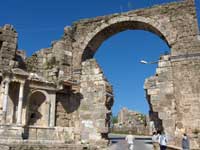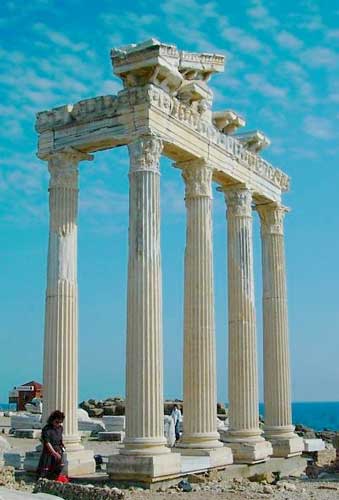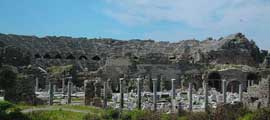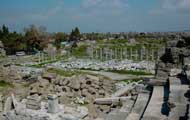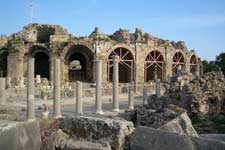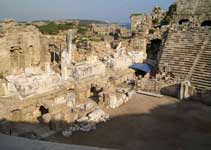.
Side (pronounced See-deh) was an ancient maritime city of Pamphylia, about 16 km from Seleucia; it currently lies on the southern coast near the village of Selimye (about 75 km from Antalya), in Antalya Province, in the Asian part of Turkey. [1]
Temple of Apollo (Source)
Side is located on the eastern part of the Pamphylian coast, which lies about 20 km east of the mouth of the Eurymedon River. Settlers from Cyme (Cumæans) in Aeolia, an ancient district of Asia Minor, founded the city in the seventh century BC. Possessing a good harbor for small-craft boats, Side's natural geography made it the most important place in Pamphylia – the region in the south of Asia Minor between Lycia and Cilicia, from the Mediterranean to Mount Taurus. Moreover, this location made Side one of the most important trade centers in its time. Today, as in yesteryear, the ancient city of Side is situated on a small north-south peninsula about 1 km long and 400 m across.
During the sixth century BC, Side fell under the rule of Lydia, a kingdom in Asia Minor. It gained partial autonomy under Persian rule after 547 BC. Side minted its own coins starting in the fifth century BC even while under Persian rule.
Alexander the Great occupied Side without a struggle in 333 BC. Alexander left only a single garrison behind to occupy the city. This occupation, in turn, introduced the people of Side to Hellenistic culture of the Greek Civilization, which flourished from the fourth century to the first century BC. After Alexander's death, Side fell under the control of one of Alexander's generals, Ptolemy, who declared himself king of Egypt in 305 BC. The Ptolemaic Empire controled Side until it was captured by the Seleucid Empire in the second century BC. Yet, despite these occupations, in the following years of the second century BC, Side managed to preserve some autonomy, grew prosperous, and became an important cultural center.
In 190 BC a fleet from the Greek island city-state of Rhodes, supported by Rome and Pergamum, defeated the Seleucid King Antiochus the Great's fleet, which was under the command of the fugitive Carthagenian general, Hannibal. The defeat of Hannibal and Antiochus the Great meant that Side freed itself from the overlordship of the Seleucid Empire. In the first century BC, the Cilician pirates established their chief naval base and a slave-trade center at Side.
Later the Roman general Pompey defeated these brigands in 67 BC, bringing Side under the control of the Roman Empire. Emperor Augustus, in reforming the administration of the state, placed Pamphylia (and Side) in the Roman province of Galatia in 25 BC. Side began another prosperous period as a commercial center in Asia Minor. This period would last well into the third century AD. Yet, Side did establish itself, once again, as a slave-trading center in Mediterranean. As well, its large commercial fleet at times unhesitantly tended to acts of piracy. The significance of this period of time in Side's history, nevertheless, is evident in its ruins today. Most of the present-day ruins found in Side date from this period of prosperity. Wealthy merchants, such as Modesta – albeit a wealthy yet historically unknown figure – paid for such tributes as public works, monuments, and competitions as well as the games and gladiator fights.
Side began to steady decline from about the fourth century. Even defensive walls could not stop successive invasions from highlanders from the Taurus Mountains. During the fifth and sixth centuries, Side was the seat of the Bishopric of Eastern Pamphylia. Arab fleets, nevertheless, raided and burned Side during the seventh century, contributing to its steady decline.
An inscription found on the site of the former ancient city shows it to have had a considerable Jewish population in early Byzantine times. In the twelfth century, having established itself as a large city once more, Side was yet abandoned after being sacked. Its population moved to Antalya and Side became known as Eski Adalia (Old Antalya).
The great ruins are among the most notable in Asia Minor. They cover a large promontory where a wall and a mote separate it from the mainland. During medieval times, the wall and mote were repaired. The promontory houses a wealth of structures. There are colossal ruins of a theater complex built much like a Roman amphitheater that relies on arches to support the sheer verticals. The Roman style was adopted because Side lacked a convenient hillside that could be hollowed out as in the usual Greek fashion more typical of Asia Minor. The theater is less well preserved as that at Aspendos theater; but it is very nearly as large. With time and the shifting of the earth, the scena wall has collapsed over the stage and the proscenium is in a cataract of loose blocks.
Other than the theater, the remaining ruins of Side include three temples, an aqueduct, and a nymphaeum. Side's nymphaeum – a grotto with a natural water supply dedicated to the nymphs – was an artificial grotto or fountain building of elaborate design.
Side have given its name to an Anatolian pomegranate, a symbol for abundance and fertility.
Today Side is a popular vacation destination. It was a favourite spot for watching the solar eclipse of March 29, 2006.
See also
Links
This article incorporates text from the 1911 Encyclopædia Britannica, a publication in the public domain.
| Ancient Greece
Science, Technology , Medicine , Warfare, , Biographies , Life , Cities/Places/Maps , Arts , Literature , Philosophy ,Olympics, Mythology , History , Images Medieval Greece / Byzantine Empire Science, Technology, Arts, , Warfare , Literature, Biographies, Icons, History Modern Greece Cities, Islands, Regions, Fauna/Flora ,Biographies , History , Warfare, Science/Technology, Literature, Music , Arts , Film/Actors , Sport , Fashion --- |
Retrieved from "http://en.wikipedia.org/"
All text is available under the terms of the GNU Free Documentation License


